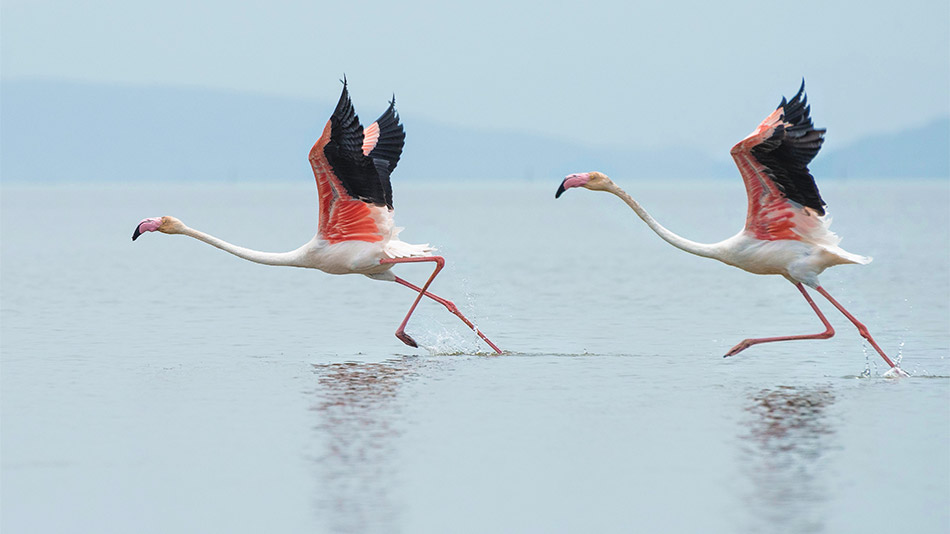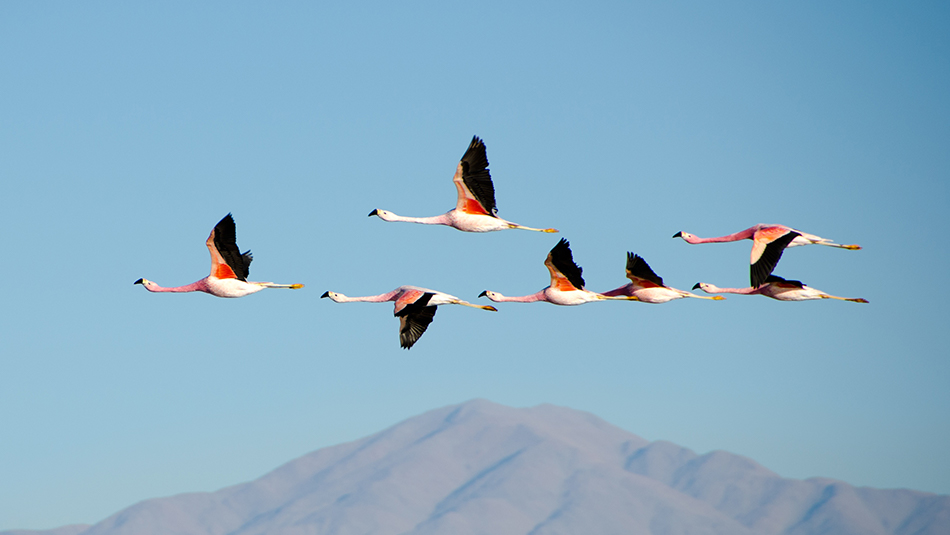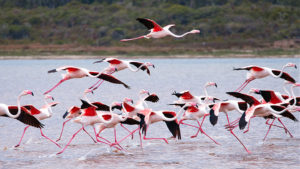We often see flamingos pictured gracefully walking with their elongated necks and long feet, and it is not often clear if they can fly at all. After finding out that flamingos do fly, I could not help finding out how good of flyers they are.
So, can flamingos fly? Yes, flamingos can fly and often fly even long distances.
How fast flamingos fly? The average flying speed of flamingo is about 35 mph (60 km/h). Flamingo flock’s long distance travel speed varies according to wind conditions and can be between 30-40 mph (50-65 km/h).
How long distances can flamingos fly? Flamingos can travel by flying up to 375 miles (600 km) in one night.
How high can flamingos fly? Flamingos have been spotted flying 15,000 feet hights (4,5 km), and commonly flying around 10,000 -13,000 feet (3-4 km).
Flamingos prefer flying in higher altitudes when flying during the daylight. Flying higher elevations helps to save energy during longer flights – same way than airplanes save energy by flying high altitudes.
Have you ever wondered how such a tall creature can take off or why they do not fly away in the zoos? What about, when baby flamingos can fly? All that and more below!

So, How do Flamingos Take Off?
Flamingos take off by:
- Starting vigorous flapping their wings.
- Pedaling on water or taking quick steps on the ground with their feet to help gain initial flying speed.
- Continuing flapping wings and pedaling with their feet until airborne.
So, flamingos need a short runway to get enough speed under their wings to start carrying their weight. It also seems to be easier for them to take off against the direction of the wind.
How About the Landing?
When flamingos are landing, they are slowing down by gaining an upright position by lifting their head and pushing their feet downward and forward. Their speed slows down nearly to zero just before their feet touch the ground. At the touchdown, they receive the gentle landing impact with few steps or with few pedaling movements if they land to water.
Flamingos land surprisingly smoothly and immediately extend to their graceful upright position after the landing.

What is The Flying Position of Flamingo?
Flamingos extend their neck forward and their long feet backward to align like an arrow with the flying direction. They have fully extended their wings to their sides and continuously flap during their flight.
When flamingos are flying, their wing underside is exposed to people observing them from below. Did you know that underside of flamingos’ wings is black? When flamingos are flying, we can see the beautiful contrast with the black underside of their wings with their pink body.
Do Flamingos Fly in Formations?
Yes, when flamingos fly long distances, the flock is organizing itself to the different shaped formations where the birds are flying tightly close to each other.
Flamingos need to flap pretty much all the time when they are flying and flapping close to each other helps them collectively to push through the air resistance.
The flock flying speed varies according to the wind and is between 30-40 mph (50-65 km/h). Flamingos are reported to prefer clear weather and a brisk tailwind.
Most likely, by changing their flying formation, the flock can use various wind patterns to their benefit. Often seen flying formation is the classic V-formation but also more irregular line and ball-like flight formations can be
observed.
During flying in a flock, flamingos are making loud honking noises similar to geese. This communication helps them to organize themselves in the flying formation. Some say that flamingos are able to communicate about location, possible dangers and that they have call and response sounds for locating their partners and parents.
When flamingos start to land, the formation and flock are scattered, and the landing process seems to be a totally uncoordinated beautiful chaos where each individual just tries to find a sweet spot to land.
What Age Do Flamingos Learn to fly?
Flamingos take good care of their offspring for first months and during first weeks flying is not part of the flamingos’ educational agenda. Flamingos develop flying feathers after 11 weeks their hatching, and they start naturally make flying attempts after the flying feathers have grown enough.
Around at 2-3 months of age young flamingos start to fly the first time. At this point, they have not developed their pink color yet so don’t wonder if some flamingos in the overflying flock are still more gray color.
Related Questions
Why Is It Challenging to Spot Flamingos Flying in the Sky Outside Their Colony Landing Locations?
We do not often spot flamingos flying in the sky due to the high altitude that they are flying during the bright daylight and mostly, because they prefer to fly long distances during the night.
Why do flamingos fly? Why they just don’t stick around?
Flamingos like their peace and if they are disturbed they prefer to have a small short distance escape flight. When human is approaching wild flamingo and gets too close this is most likely to happen.
Flamingos are considered mainly as non-migratory species, meaning that they mostly stay in the same location. But this is not entirely the whole truth.
These birds live in very different locations and altitudes that are prone to weather changes. They relocate themselves according to their needs around the year or if there are any changes in the ecosystems.
Here are the most common reasons why flamingos relocate:
- Some high altitude locations get too cold during Winter
- Some more north locations get too cold for flamingos during Winter
- Seasonal water level changes (flamingos like shallow water)
- The area cannot provide food or living conditions get otherwise difficult
Flamingos typically start relocating themselves when the weather gets remarkable chilly, or other significant changes begin to happen. They do not always seem to have preterminated destination but follow the first suitable wind that takes them to warmer or otherwise better location.
Flamingos love lakes and water, so they are mainly moving from lake to lake.
Flamingos may find a more suitable place for themselves to temporarily enjoy their life, but they have a tendency to return back to their native colony location for breeding. So, that means flying again, and often long distances!
What Proof We Have About the Flying Height of Flamingos?
Large bird flocks show up on radar. There is exact radar information of the flying time and height of the passing flock. This information can be combined with visual recognition of the species, and this helps us to define some typical soaring heights.
One of the most definite proofs of flamingos’ flying capabilities are high altitude colonies, such as Laguna Colorada lake in Bolivia located at an elevation of 14,035 ft (4,278 meters). Thousands of flamingos from different species are flocking there, usually from December through April. And, they must get there by flying!
Why Do Flamingos Not Fly Away in Zoos?
When flamingos get food and are safe from predators, they naturally have less reason to relocate themselves by flying. And even then, escaped flamingos are not rare at all. So, flamingos sometimes actually do fly away from captivity and found on areas that they do not naturally live.
To prevent flamingos from escaping many zoos practice clipping Flamingos’ wings to prevent them from flying away.
The clipping is done by trimming birds’ primary flying feathers. This clipping is considered painless when done by a trained veterinarian. Some birds in captivity have got used to humans care, but for a wild or untamed bird, the process of capturing and holding down the bird for this operation and losing its natural flying capability is a traumatic experience.
Sadly, the wing clipping practice is not only limited to zoos. Some tourist destinations are rumored to do this to flamingos to keep them more extended periods in the same location and to be more dependent on human feeding.
Please, if you are planning a flamingo vacation, prefer to observe wild flamingos in their natural habitats to enjoy their wild grace in all spectrums of standing, taking off, flying and landing.
